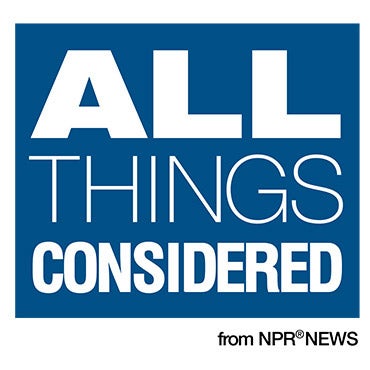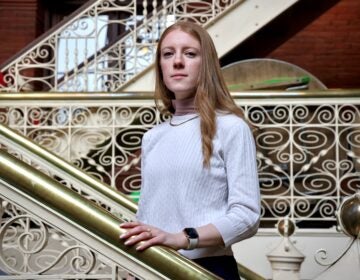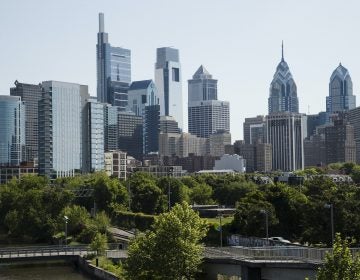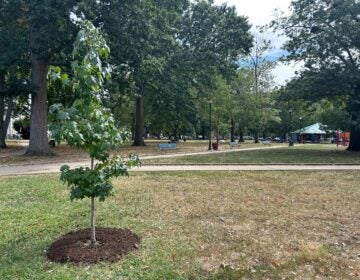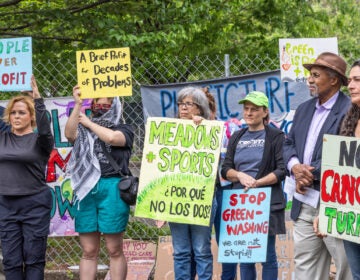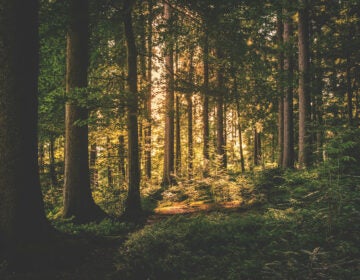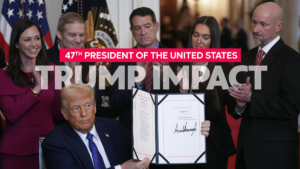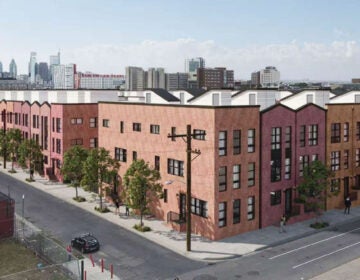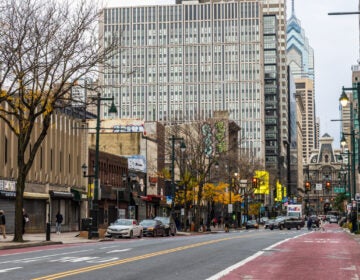Philadelphians push the city to do more to plant and protect trees
One possible challenge: Officials say a $12 million federal grant to help implement the Philly Tree Plan is frozen.
Listen 1:00
File: A block in Philadelphia with mature shade trees shown in 2020. (Marcus Ferreira)
This story is part of the WHYY News Climate Desk, bringing you news and solutions for our changing region.
From the Poconos to the Jersey Shore to the mouth of the Delaware Bay, what do you want to know about climate change? What would you like us to cover? Get in touch.
Philadelphians said there’s still work to do to keep the city’s trees standing and ensure every resident has equal access to them during a hearing about the city’s implementation of the Philly Tree Plan.
The plan aims to reverse a trend of tree loss in the city by preserving existing trees, reducing the burden that trees pose to residents, improving customer service and caring for newly planted trees. Parks Commissioner Susan Slawson said these goals take time, and the city is making progress.
“I think we’re in a good place, based on the fact that this is a 10-year plan,” Slawson said.
Here are key takeaways from the hearing.
A $12 million grant for Tree Plan implementation is frozen
Department of Parks and Recreation officials said during Wednesday’s hearing before City Council’s Committee on the Environment that the city and its nonprofit partners do not currently have access to a $12 million grant to help implement the tree plan, which was funded by the Inflation Reduction Act and finalized last year. On his first day in office, President Donald Trump ordered federal agencies to pause grant payments under the act.
When the grant was announced, city officials touted it as the “largest investment in Philadelphia’s urban forest in almost 30 years.” It is intended to fund the administrative costs of setting up a new nonprofit, housed under the Pennsylvania Horticultural Society, to coordinate implementation of the Tree Plan. It is also meant to fund tree planting and maintenance.
“To your knowledge, do we have access to that funding?” asked District 3 Councilmember Jamie Gauthier, who led Wednesday’s hearing.
“We do not,” Slawson said.
The U.S. Department of Agriculture did not immediately respond to a request for comment.
Trees remain a measure of environmental inequity in Philly
Some Philadelphia neighborhoods have less than 5% tree cover, while others have more than 45%, according to the Tree Plan.
“Low-income and communities of color have fewer trees and are hotter than higher-income neighborhoods,” Gauthier said. “This is as much of an equity, safety and health issue as it is a sustainability one.”
The city has found that neighborhoods designated as “hazardous” on a historic racist redlining map now correlate with the areas of lowest tree coverage today.
“People living in neighborhoods with low canopy cover and limited green spaces suffer from hotter temperatures during the summer, which is a growing concern as temperatures rise,” Hamil Pearsall, a professor at Temple University who studies gentrification, environmental justice and sustainable infrastructure, testified during the hearing. “This is a clear environmental justice issue.”
These patterns contribute to health disparities, said Children’s Hospital of Philadelphia pediatrician Paul Devine Bottone.
“Neighborhoods that have the least tree cover are, not coincidentally, the same neighborhoods that were redlined 80 years ago, and the same neighborhoods that today have the highest rates of childhood asthma, Type 2 diabetes and gun violence and its associated traumas,” he said.
The Tree Plan aims to fix disparities by focusing city and nonprofit efforts on priority areas of the city, eventually bringing tree coverage to 30% in every neighborhood.
“The greatest thing about this tree plan is that it aims to correct this unequal distribution,” said Dominique London, executive director of UC Green, which plants and maintains trees in West and Southwest Philly.
Barriers still stop residents from getting trees in front of their homes
Physical barriers to planting street trees in front of homes, including cracked sidewalks and old stumps that need to be ground down, can be too expensive for homeowners to fix, London said.
“All these are the responsibility of the homeowner before they can even get a tree,” London said.
Because tree plantings must be approved by property owners, renters often have a hard time getting trees planted, she said. So UC Green approaches landlords and property owners on behalf of their tenants.
“If you want to get a street tree planted in Philadelphia, you have to sign the application,” London said. “In order to sign the application, you have to be the homeowner.”
Residents are upset about tree loss on public parkland
Several commenters during Wednesday’s hearing said projects on public land have undermined the goals of the Tree Plan.
In 2022, residents were shocked to find hundreds of trees cut down at the city-owned Cobbs Creek Golf Course as part of the renovation of the shuttered, historic course and restoration of the creek. More recently, tree clearing for the renovation of South Philly’s FDR Park, including for the creation of a wetland to address flooding issues, has sparked outrage from some park users.
“FDR Park must never happen again,” said arborist Hal Rosner.
Rosner testified that a 2022 law that expanded requirements for developers around preserving and replacing trees and implemented new fees if they fail to meet them, should be stronger. The law exempts sites of affordable housing and environmental restoration projects, including wetland creation, while removing an exemption for parks.
“One ongoing area of investigation is the impact of the exemption to tree planting requirements … near certain affordable housing developments, denying the benefits of trees to this already vulnerable population,” said Gyan Moorthy, a medical student at the University of Pennsylvania who works on a tree planting and policy initiative there.
More tree maintenance is needed
Raven Green, the tree program coordinator at Bartram’s Garden, has witnessed the tree loss in Philly firsthand. Green says despite the many benefits of trees, they’re often viewed as a burden.
“Some of the blocks where I used to live, trees are completely gone,” Green said. “I ask residents and neighbors like, what happened? … My sidewalk, my infrastructure, it cost too much.”
Homeowners often worry tree roots will disrupt sidewalks or underground pipes, or that fallen leaves will clog drains. Tree planting programs now focus on planting the “right tree in the right place,” so that trees are the appropriate size for their environment, and many tree planting organizations, including UC Green, also provide tree maintenance.
Cat McManus, who helps lead Francisville Tree Tenders group in North Philly, testified that she experienced pushback from a local pastor when watering trees in her neighborhood.
“Why wasn’t he open to new trees? Easy. He knew the city wouldn’t maintain them,” McManus said. “So we really have to reduce that burden on city residents. It’s clear we do have a way to go on this front.”
‘We’re in a good place’
Despite the issues raised by tree advocates Wednesday, Department of Parks and Recreation officials say they’re making progress on the Tree Plan’s goals.
The department planted over 3,700 trees along city streets, in parks and as part of the yard tree giveaway last fiscal year, Slawson said. A recent increase in the department’s budget for tree maintenance resulted in the city pruning over 2,300 trees since 2023, with an additional 2,700 tree prunings planned between now and July. The city has also launched an initiative to plant trees along commercial corridors.
Parks and Rec is “actively growing” its capacity for tree maintenance on streets and in parks, including through workforce development partnerships, Slawson said. The department is also working on moving from a “reactive” maintenance model to a “proactive” cycle of tree inspections.
“Proactive maintenance of trees is crucial for trust building with residents, who are more willing to plant trees on and around their property when they know that those trees will be properly maintained,” she said.
The first step in moving to the proactive maintenance model is surveying the age and species of trees in the city, a project the department hopes to work on with the U.S. Forest Service, Slawson said.
Trust-building efforts by the city and its community partners are starting to show signs of success, said Parks and Rec Community Forestry Manager Erica Smith Fichman, with the most requests for street trees in the past six months coming from some of the ZIP codes with the lowest tree canopy.

Subscribe to PlanPhilly
WHYY is your source for fact-based, in-depth journalism and information. As a nonprofit organization, we rely on financial support from readers like you. Please give today.

